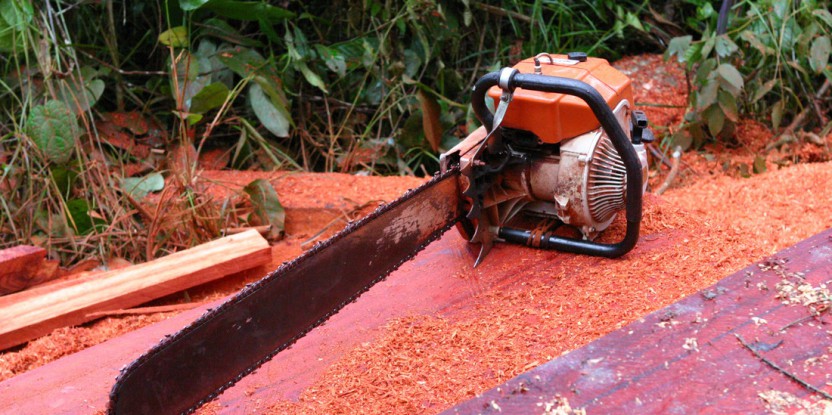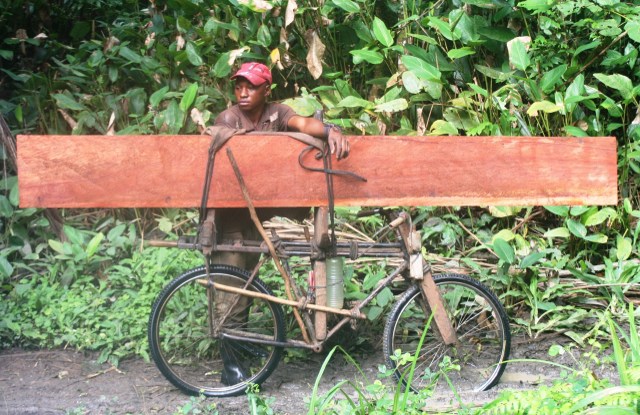
KATIOLA, Côte d’Ivoire—Mr. Aboubakar, who has been working as a carpenter in his native Côte d’Ivoire for the past 25 years, sits with our team of researchers answering our questions to help us better understand the domestic, artisanal timber sector in his country.
In the eyes of those concerned with the future of forests in Africa, Mr. Aboubakar doesn’t even exist.
And yet there are untold numbers of people just like Mr. Aboubakar in sub-Saharan Africa, people whose livelihoods depend on the artisanal timber sector—carpenters, cabinetmakers, wood sellers, transporters and loggers. No matter which wood market you visit across Africa—Abidjan, Accra, Yaoundé, Kinshasa, Kampala or Nairobi—you will find the same thing: mountains of boards for sale and logs hewn with chainsaws, to satisfy the ever-growing local demand for timber on a continent that is intent on “constructing” itself.
In the past seven years, our team from the Center for International Forestry Research (CIFOR), together with the French agricultural and development research center CIRAD and numerous national partners in several African countries, has focused on domestic wood markets, conducting in-depth research on their importance and how they function.
Our work shows that we are talking about hundreds of thousands of people who live off this sector directly or indirectly, and also about millions of cubic meters of wood—often in volumes higher than those officially exported to Europe or to China. We are also talking about millions of consumers in need of this timber.
AN ENTIRE MARKET, IGNORED
This is why it is so surprising to find this domestic timber production missing from international and national databases on timber production on the continent—particularly those that usually serve as reference guides for experts in the timber sector, academics, the media, politicians and policy makers. If you consult, for example, the statistical web pages of the FAO, or the International Tropical Timber Organization (ITTO), or UN Comtrade, which maintains data and statistics on trade in basic commodities, you will see that they contain no data on production of or demand for domestic timber.
In effect, it appears as if there is no such thing as an African market for timber.
How can this be? There are many reasons specific to individual countries, which have been detailed by CIFOR, the European Tropical Forest Research Network (ETFRN), and the Central African Forest Commission (COMIFAC), among others.
But on a more general level, we can point to the various economic crises of the 1980s and the structural adjustment programs of the 1990s, during which most forestry legislation in sub-Saharan Africa was revised to emphasize industrial timber production. The main aim was to replenish empty state coffers so that growing debts could be repaid, the idea being that it was easier to tax and regulate large logging corporations than domestic players in the artisanal logging sector.
As a result, only industrial timber was taken into account in national and international statistics on “official” timber production and exports; in other words, only those who paid tax and produced for international export were included.
EVERYONE’S A CRIMINAL
At the same time, harvesting and sales by people working at a small scale—chainsaw millers, local timber merchants and smallholders clearing farm fields and selling the wood—completely disappeared from the books, becoming invisible to policy and statistics, if indeed they had ever really been included. Even worse, some countries adopted laws—still in effect today—that render artisanal logging operations illegal.
The legislation did nothing to diminish local consumption of informally produced domestic timber, which has continued to grow, along with increasing populations, urbanization and standards of living. However, it did mean that those working in the artisanal logging sector, whom the laws labeled as criminals and the statistics said did not exist, were unable to make their voices heard. Today the domestic logging sector remains informal nearly everywhere in Africa, operating beyond the scope of or even contrary to ill-adapted legislation.
In 2015, the year of the Sustainable Development Goals, such a situation is no longer acceptable. Our research clearly shows that small-scale operators supplying domestic and regional markets in Africa are demanding recognition, both political and economic. They are requesting rights and responsibilities, including paying genuine taxes instead of “envelopes” with bribes delivered to state officials who do nothing to promote best practices in the sector and who continue to undermine good governance by encouraging corruption.
Fortunately, it appears that these demands are not going unheard. In 2013, the European Union enacted legislation that imposes fines for the importation of illegal timber to its member states. In this context, some countries that export tropical wood to the EU decided to improve their legislative frameworks, most notably by negotiating trade agreements with the EU called Voluntary Partnership Agreements (VPAs). And: Surprise! Suddenly everyone “discovered” that a forestry sector comprising small enterprises and many thousands of operators does indeed “exist” in sub-Saharan Africa, and that it has enormous social, ecological and economic importance.
Our hope is that this “discovery” will now lead to open and transparent dialogue on the role that the artisanal logging sector can play in development at national and regional levels, and how best its positive contributions can be promoted and its more negative impacts minimized. It is obvious that, in some cases, the informal timber sector contributes to deforestation and degradation of forest resources, something of which the operators themselves are often aware. But if the sector remains invisible and criminalized, how can solutions be found and improvements made to make it less destructive and more sustainable?
SLIVERS OF HOPE
A few recent signs suggest that there is room for cautious optimism. For the first time, several African governments organized roundtable discussions, in the context of VPA discussions with the EU, which brought together state officials, large industrial timber companies and operators from the artisanal domestic logging sector. The latter are numerous, often poorly organized, and sometimes still unable to speak with a single voice, but one thing is now eminently clear: They exist and they must not be ignored any longer.
Although it may take some time for the policy arena to acknowledge and integrate these operators, some well-targeted support from national and international institutions that claim to serve these operators and the environment could expedite their recognition and inclusion in statistical records. This will not change their lives overnight, but the processes and negotiations that will be undertaken nationally to produce these statistics for the country itself, for FAO, ITTO and for all other users, will be crucial in helping governments recognize the political and economic importance of the domestic timber sector.
For Mr. Aboubakar in Côte d’Ivoire, that could mean the difference between his current life spent in fear that each day may land him in prison (or bribing officials to keep himself out of it), and a fulfilling life spent training young employees, doing work he enjoys while earning enough money to feed his family and send his three children to school, and feeling proud that he is able to work and contribute to the development of his country.
CIFOR’s research on artisanal logging in Africa forms part of the CGIAR Research Program on Forests, Trees and Agroforestry.
We want you to share Forests News content, which is licensed under Creative Commons Attribution-NonCommercial-ShareAlike 4.0 International (CC BY-NC-SA 4.0). This means you are free to redistribute our material for non-commercial purposes. All we ask is that you give Forests News appropriate credit and link to the original Forests News content, indicate if changes were made, and distribute your contributions under the same Creative Commons license. You must notify Forests News if you repost, reprint or reuse our materials by contacting forestsnews@cifor-icraf.org.


